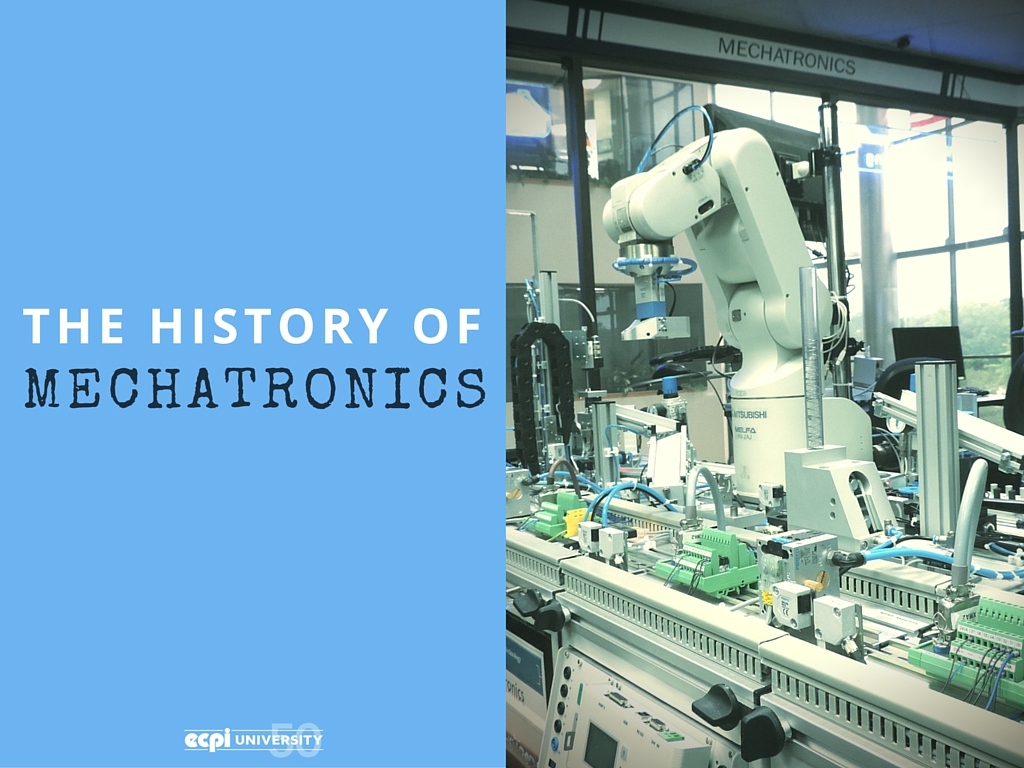What is The History of Mechatronics?
It's always exciting when a new field emerges that offers opportunities to integrate various disciplines in a fresh way. Mechatronics is such a field, and as it evolves, it's revolutionizing the way products are designed, from car rear-view mirrors to automated door opening systems to robotics.
The obvious appeal of these new systems and devices to the business world and the public at large means we may never again think of mechanical, electronic, and computer engineering as distinctly separate disciplines. Rather, as mechatronics continues to synthesize these disciplines in the creation of exciting new technology and products, the divisions between these fields are becoming less distinct.
What is Mechatronics?
Chances are, you may not have heard of the catch-all term "mechatronics," so in a nutshell, here's what it means: mechatronics integrates various engineering disciplines in the design, development, and application of new smart devices. Students of mechatronics learn how to create, fabricate, and test these new systems that we're all coming to rely on -- as well as products that haven't yet been envisioned.
Take robotics, one of the main fields where the synthesis of mechanical, electronic, and computer engineering has had a profound impact. Mechanical systems control gears and wheels, actuators and arms, while electronic systems control movement and produce power. Over the last couple of decades, the addition of computer-aided design software has revolutionized control systems so that robotics operate in a more fluid manner, thus allowing ever more sophisticated uses and adaptations.
Another example is in the design of car rear-view mirrors. A few years ago a car mirror was just that. Now they have cameras, and register temperature and compass direction by means of sensors. You can thank mechatronics for these improvements, which have resulted in a more integrated approach to design.
Additional examples of mechatronics applications are:
- Anti-lock brakes
- Photocopiers
- Humidity-sensitive windshield wipers and clothes dryers
- Computer disk drives
You will also find mechatronic devices in agriculture, medicine, homes, commercial buildings, toys, and in aids for the disabled and elderly.
Where Did Mechatronics Come From?
The word mechatronics was first used in Japan in the 1960s, and the field has been said to have grown out of robotics. Early on, robot arms were uncoordinated and had no sensory feedback, but as advances were made in programming, sensor technology, and controls, the robotic movements became more coordinated. Along the way, advances in mechatronics began to be used in vending machines, auto-focus cameras, and door openers. With the advent of information technology in the 1980s, microprocessors were introduced into mechanical systems, improving performance significantly. By the 1990s, advances in computational intelligence were applied to mechatronics in ways that revolutionized the field.
The concept of applying the mechatronics approach to design, development, and fabrication has been popular for several decades in Japan and Europe, but is only slowly gaining ground in the United States. Machines were traditionally designed by mechanical engineers, and only afterward were control and programming solutions provided by computer and software engineers. As familiarity with mechatronics has grown in this country, designers have come to see this more sequential approach as inefficient, and are adopting more integrated design methods.
An Emerging Field for Students
Mechatronics has great appeal for those interested in how things are made and how they work. Students in a typical program learn to design, develop, and troubleshoot programmable controllers, robotics, and integrated systems. The skills picked up in a course of study can be used in the fields of maintenance and repair, quality assurance, research and development, and installation.
Mechatronics can be a rewarding field for people with skills in electronics, computers, automated machinery, and manufacturing. Students with combined skills in mechanical, electrical and software engineering could find that they have a natural aptitude for mechatronics. A program that combines book theory and hands-on exercises in robotics as well as these technologies could help provide the requisite knowledge and experience for a future in mechatronics.
Great news Bob Larned! Love your Mechatronics Program graduates! https://t.co/58Be8nBSE0
— Sultan Camp ツ (@careersultan) November 13, 2015
Do you think a degree in mechatronics might be right for you? At ECPI University, you could earn a Bachelor of Science Degree in Mechatronics in as little as 2.5 years, by enrolling in our accelerated, year-round schedule. Contact ECPI University today to talk to an admissions advisor.
It could be The Best Decision You Ever Make!
DISCLAIMER – ECPI University makes no claim, warranty, or guarantee as to actual employability or earning potential to current, past or future students or graduates of any educational program we offer. The ECPI University website is published for informational purposes only. Every effort is made to ensure the accuracy of information contained on the ECPI.edu domain; however, no warranty of accuracy is made. No contractual rights, either expressed or implied, are created by its content.
For more information about ECPI University or any of our programs click here: http://www.ecpi.edu/ or http://ow.ly/Ca1ya.




